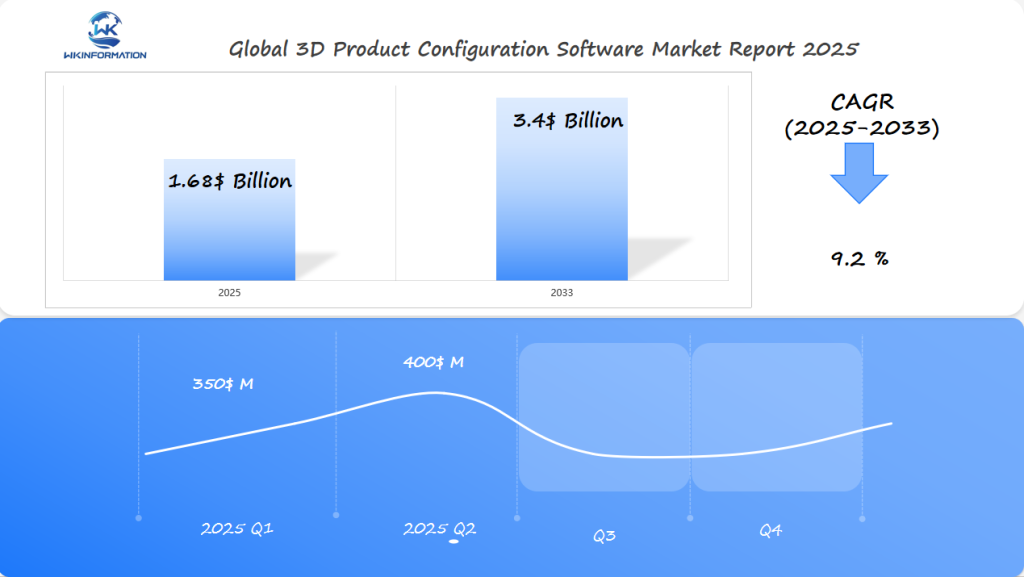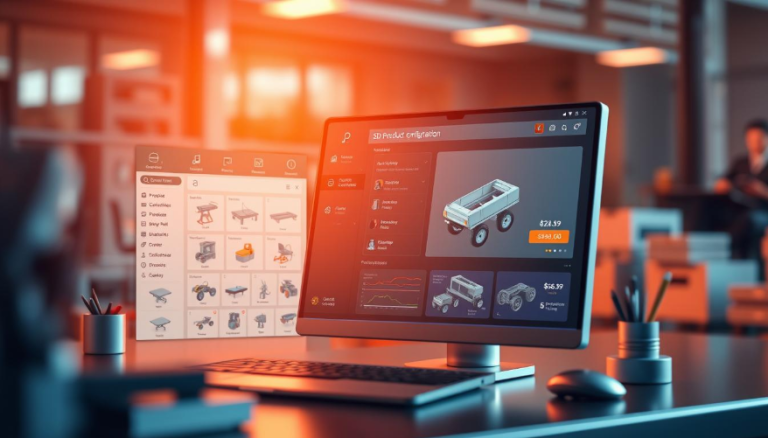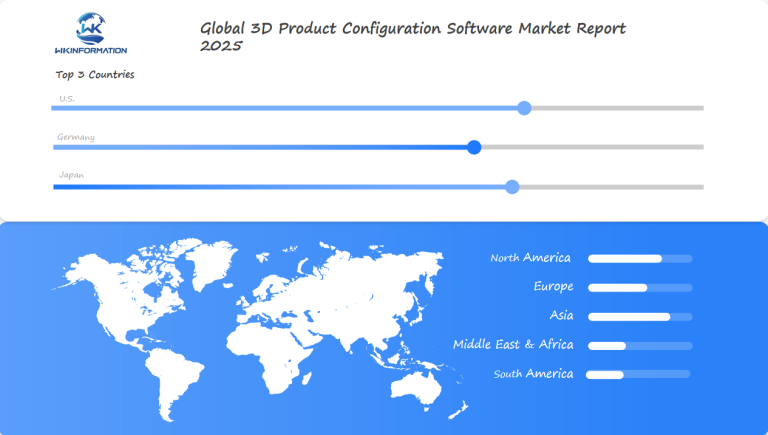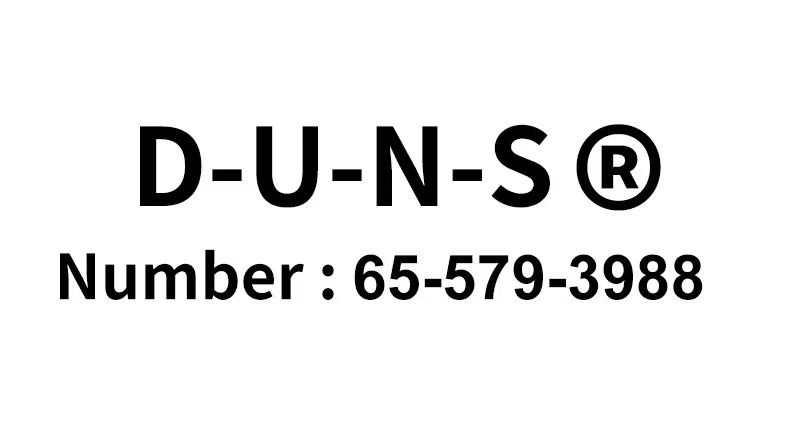3D Product Configuration Software Market Set to Surpass $1.68 Billion by 2025: Key Drivers from the U.S., Germany, and Japan
Explore the evolving 3D Product Configuration Software Market trends, growth drivers, and competitive landscape. Discover how digital transformation is shaping product customization solutions.
- Last Updated:
3D Product Configuration Software Market Outlook for Q1 and Q2 of 2025
The 3D Product Configuration Software market is expected to reach $1.68 billion by the end of 2025, with a CAGR of 9.2% from 2025 to 2033. In Q1 of 2025, the market size is estimated to be $350 million, as manufacturers across various industries look to optimize product design and enhance customer engagement through virtual configuration tools. By Q2, the market is expected to reach $400 million, driven by the growing demand for personalized products and the rise of e-commerce.

Key Takeaways
- The market is projected to reach $1.68 billion by 2025.
- Advanced visualization transforms product development processes.
- There is an increasing demand for personalized product experiences.
- 3D configuration technologies are being adopted across various industries.
- Design and engineering workflows are experiencing significant improvements.
Upstream and Downstream Market Dynamics in 3D Product Configuration Software
The 3D product configuration software market is complex. It connects manufacturers, software developers, and end-users through a supply chain. This setup drives innovation and growth in various tech sectors.
Several forces shape the industry:
- Technological advancements in software development
- Increasing demand from manufacturing sectors
- Enhanced customization capabilities
- Integration of artificial intelligence
Upstream Dynamics: Software Developers and Tech Providers
At the top of the supply chain are software developers and tech providers. They create advanced configuration platforms. These innovators design solutions that transform traditional manufacturing processes. They make tools that help manufacturers design products faster, cut down on time-to-market, and offer more personalized experiences.
Downstream Dynamics: Distributors, End-Users, and Industry Teams
On the other side, we have distributors, end-users, and industry teams. Their needs push software to evolve. This creates a cycle of improvement in 3D product configuration technologies.
Current Trends: How Manufacturers are Adapting
Manufacturers are now using these software solutions to stay ahead. They see the benefits of lower development costs, quicker prototyping, and better customer engagement.
Future Outlook: Collaborations Driving Change
Collaborations between software developers and end-users are speeding up tech advancements. This ensures 3D product configuration software stays at the forefront of digital change.
Trends Shaping the 3D Product Configuration Software Market in 2025
The 3D product configuration software market is changing fast. Digital transformation and new technologies are leading the way. Companies from different fields are usingartificial intelligenceandaugmented realityto change how products are made and how customers experience them.
2025 is bringing big changes incustomizationand technology:
- Advanced AI algorithms for super-personalized product designs
- Augmented reality tools for real-time product interactions
- Cloud-based platforms for easy design collaboration
- Machine learning for predicting what customers will like
Manufacturers are moving towards digital transformation. They want flexible, smart configuration systems. This shift to interactive product development is a big step in software engineering. It lets businesses make products that fit exactly what customers want.
Artificial intelligence is making configuration easier. AI looks at lots of data and user actions. It then suggests products and tweaks designs on the fly.
Investments in augmented reality are making product visuals more real and fun. Customers can now play with virtual product models. They can change every detail before buying.
Barriers to Growth in the 3D Product Configuration Software Market
The 3D product configuration software market has big hurdles to overcome. Technical complexity is a major issue for companies trying to fit these advanced tools into their current systems.
Key barriers to market growth include:
- High initial investment costs for sophisticated software platforms
- Steep learning curves for design and engineering teams
- Integration issues with legacy manufacturing systems
- Limited technical expertise in advanced 3D configuration technologies
Companies face big technical challenges when trying to use 3D product configuration software. These solutions need special skills and a big change in how the company works. Small businesses often find it hard to adopt and learn these new technologies because it takes a lot of resources.
Another big challenge is integrating these systems with what companies already use. Many find it hard to link 3D configuration platforms with their ERP and CAD systems. This can make things less efficient and reduce the benefits of using this software.
To successfully navigate these barriers, companies must:
- Invest in comprehensive staff training programs
- Develop strategic implementation roadmaps
- Partner with experienced software vendors
- Gradually integrate 3D configuration technologies
Overcoming these challenges requires a holistic approach that balances technological innovation with practical business considerations.

Geopolitical Challenges and Opportunities in 3D Product Configuration
The world of 3D product configuration software is changing fast. Global trade is changing how companies make and share software. This affects how they work together across borders.
Challenges
There are big challenges from different rules in each market. Companies face complex laws that affect how they share technology and use software worldwide.
- Regulatory compliance differences between markets
- Complex international intellectual property protections
- Data privacy and security regulations
Opportunities
But there are also chances for working together across borders. Companies that handle these challenges well can grow their markets and tech skills.
| Geopolitical Factor | Impact on 3D Configuration Software | Strategic Response |
| Regulatory Complexity | Increased Market Entry Barriers | Localized Compliance Strategies |
| Trade Restrictions | Limited Technology Transfer | Regional Partnership Development |
| Data Protection Laws | Software Customization Requirements | Adaptive Software Architecture |
Being flexible is key in dealing with global trade changes. Companies need to create tech that can quickly adapt to new rules. This keeps them competitive and innovative.
Segmentation of the 3D Product Configuration Software Market: Key Technologies and Applications
The 3D product configuration software market is growing fast. It offers different solutions for various business needs. Companies are now using advanced tools to change how they show and customize products.
There are different ways to use these tools:
- Cloud-based solutions that grow and change easily
- On-premise software for more control over data
- Hybrid options that mix different ways of using tools
Each industry is pushing for new things in these tools. Companies use them to make exact digital copies of their products. This helps them make prototypes quickly and customize them fast.
Some key technologies include:
- Interactive 3D visualization platforms
- Advanced configuration engines
- Real-time rendering technologies
- Software that can work with other systems
Businesses know that the right 3D product configuration software can really help. It can make customers more engaged and speed up getting new products to market.
Applications of 3D Product Configuration Software in Various Industries
3D product configuration software has changed how businesses in many fields show and customize their products. It’s used in manufacturing, e-commerce, and more. These tools are making it easier for customers to see what they want and helping companies design faster.
Automotive Industry
In the car world, makers use 3D tools to let customers design their own cars. People can see detailed car models, pick colors, and choose interior designs. They can even see their dream car come to life right before their eyes.
Retail Industry
Retail industries use 3D configuration to enhance online shopping experiences
Furniture Industry
Furniture companies enable virtual room planning and product customization
E-commerce Industry
E-commerce platforms integrate interactive product visualization tools
The manufacturing world also benefits a lot from this software. Precision digital modeling helps companies save on prototypes and speed up making products. Designers can try out different designs and test them before making them real.
Furniture stores see big wins by using 3D tools. Customers can pick everything from sofa sizes to fabrics. This lets them make products that fit their exact needs.
Online shops are adding these tools to make shopping more fun. By letting customers see products in their own homes, stores can cut down on returns. This makes customers happier and more likely to shop again.
Global 3D Product Configuration Software Market: Regional Insights
The global 3D product configuration software market shows different growth patterns in each region. North America leads with a big market share. This is thanks to its focus on technology and digital change.
Each region has its own special traits:
- North America: Dominates with advanced technological infrastructure
- Europe: Strong manufacturing sector supporting software adoption
- Asia-Pacific: Rapid digital transformation and emerging tech ecosystems
Looking at regional growth, we see different trends. In North America, companies spend a lot on making software better. They create complex solutions.
In Europe, the focus is on using software in making things. They use their precision engineering skills.
The Asia-Pacific region is growing fast. Countries like Japan, South Korea, and China are moving quickly to digital manufacturing. This opens up new chances for 3D product configuration software.
Investments and new tech keep changing the market. New countries are getting interested in these advanced technologies. This shows a bright future for the market.

The U.S. Market for 3D Product Configuration Software: Advancements in Customization
The U.S. market for 3D product configuration software is changing fast. New customization technology and changing what people want are driving this change. Businesses in many fields are using new digital tools to offer more personalized products.
Important changes in the U.S. market trends include:
- Rapid integration of artificial intelligence in configuration platforms
- Enhanced real-time visualization technologies
- Increased focus on user-friendly interface design
- Seamless cross-platform compatibility
Manufacturing and retail are big winners with these new technologies. Companies are spending a lot on advanced 3D tools. These tools let customers design products with great detail. Customization technology makes it easy for people to see and change virtual products, making shopping more fun.
This change isn’t just for making things. The car, furniture, and electronics industries are also changing. They use advanced software to meet the demand for unique, made-to-order products.
The U.S. market is expected to keep leading in customization technology. It will set new standards for how products are made and how people interact with them.
Germany's Impact on the 3D Product Configuration Software Market: Industrial Usage
The German manufacturing sector is leading in technology, making big steps in 3D product configuration software. Germany’s focus on Industry 4.0 makes it a world leader in digital industrial changes.
Germany’s strengths in 3D product configuration include:
- Precision engineering capabilities
- Strong investment in research and development
- Advanced manufacturing technologies
- Robust digital transformation strategies
Top German manufacturers are using advanced product configuration technologies to make production smoother and more customizable. Companies like Siemens and BMW are leading in technological innovation.
Germany’s use of Industry 4.0 has made its companies more flexible, efficient, and responsive. With 3D product configuration software, they can get products to market faster, cut down on mistakes, and offer more personalized products.
| Technology Area | Innovation Impact |
| 3D Visualization | Enhanced Product Design |
| Digital Twin Technology | Improved Manufacturing Processes |
| AI-Driven Configuration | Intelligent Product Customization |
As global markets ask for more advanced manufacturing, Germany keeps leading in 3D product configuration software.
Japan's Role in Advancing 3D Product Configuration Software: Precision and Innovation
Japan is at the forefront of 3D product configuration software, thanks to its precision engineering and robotics expertise. The country’s consumer electronics industry has also played a significant role in driving changes in digital product customization.
Japanese Tech Leaders Making Strides
Japanese tech leaders have developed advanced 3D configuration platforms that showcase the country’s technical skills. These innovations include:
- Advanced algorithmic design techniques
- Real-time visualization technologies
- Hyper-realistic rendering capabilities
- Seamless integration with manufacturing processes
Companies like Sony, Panasonic, and Ricoh have been instrumental in pushing 3D product configuration software forward. They combine precision engineering with user-friendly designs, revolutionizing how products are customized across various industries.
The Impact of Robotics on Customization
The Japanese robotics sector has also contributed to the advancement of 3D product configuration software. Smart 3D configuration tools developed by this sector enable manufacturers to easily create unique products, eliminating complexity in the customization process.
Japan’s Continued Importance in 3D Product Configuration
As the demand for personalized products grows worldwide, Japan’s technological expertise remains crucial. The country is poised to maintain its position as a major player in the field of 3D product configuration software.
Looking Ahead: Future Developments in 3D Product Configuration Software
The 3D product configuration software market is about to undergo significant changes. We’re heading towards smarter, more immersive digital experiences. These changes will transform how businesses and customers perceive product design.
Key Areas of Development
New technologies are leading the way in this field. Some key areas include:
- Advanced AI-powered configuration algorithms
- Enhanced real-time rendering capabilities
- Seamless virtual and augmented reality integration
- Hyper-personalized product customization tools
Experts predict substantial growth in this area. Artificial intelligence will lead the way in smart product configuration systems. This will make design more complex yet easier to use.
The Impact of New Technologies
New tech will simplify design processes and engage customers more actively. Companies utilizing the latest 3D configuration tools will have a significant advantage over their competitors.
The roadmap for innovation points to several key areas:
- Machine learning-enhanced design optimization
- Cloud-based collaborative configuration platforms
- Cross-platform compatibility improvements
- Enhanced computational rendering techniques
As companies transition to digital, 3D product configuration software will play a crucial role. It will enable the creation of personalized, interactive product experiences across various industries.
Competitive Landscape in the 3D Product Configuration Software Market
Key players in the 3D product configuration software market are focusing on enhancing customization capabilities and improving user interfaces to offer more seamless and intuitive experiences. They are expanding their presence in industries such as automotive, manufacturing, and retail, where the need for personalized products is on the rise. Strategic partnerships with e-commerce platforms and advancements in augmented reality (AR) are helping these companies attract more clients and strengthen their market position.
Key Players:
-
Autodesk (USA)
-
Dassault Systèmes (SOLIDWORKS) (France)
-
Siemens Digital Industries Software (Germany)
-
PTC (Creo) (USA)
-
Configit (Denmark)
-
Tacton (Sweden)
-
KBMax (USA)
-
SAP (Germany)
-
Oracle (USA)
-
DriveWorks (UK)
Overall
| Report Metric | Details |
|---|---|
| Report Name | Global 3D Product Configuration Software Market Report |
| Base Year | 2024 |
| Segment by Type |
· Cloud-based · On-premise · Hybrid |
|
Segment by Application |
· Retail · Furniture Stores · E-commerce |
|
Geographies Covered |
· North America (United States, Canada) · Europe (Germany, France, UK, Italy, Russia) · Asia-Pacific (China, Japan, South Korea, Taiwan) · Southeast Asia (India) · Latin America (Mexico, Brazil) |
| Forecast units | USD million in value |
| Report coverage | Revenue and volume forecast, company share, competitive landscape, growth factors and trends |
Global 3D Product Configuration Software Market Report (Can Read by Free sample) – Table of Contents
Chapter 1: 3D Product Configuration Software Market Analysis Overview
- Competitive Forces Analysis (Porter’s Five Forces)
- Strategic Growth Assessment (Ansoff Matrix)
- Industry Value Chain Insights
- Regional Trends and Key Market Drivers
- 3D Product Configuration Software Market Segmentation Overview
Chapter 2: Competitive Landscape
- Global 3D Product Configuration Software Players and Regional Insights
- Key Players and Market Share Analysis
- Sales Trends of Leading Companies
- Year-on-Year Performance Insights
- Competitive Strategies and Market Positioning
- Key Differentiators and Strategic Moves
Chapter 3: 3D Product Configuration Software Market Segmentation Analysis
- Key Data and Visual Insights
- Trends, Growth Rates, and Drivers
- Segment Dynamics and Insights
- Detailed Market Analysis by Segment
Chapter 4: Regional Market Performance
- Consumer Trends by Region
- Historical Data and Growth Forecasts
- Regional Growth Factors
- Economic, Demographic, and Technological Impacts
- Challenges and Opportunities in Key Regions
- Regional Trends and Market Shifts
- Key Cities and High-Demand Areas
Chapter 5: 3D Product Configuration Software Emerging and Untapped Markets
- Growth Potential in Secondary Regions
- Trends, Challenges, and Opportunities
Chapter 6: Product and Application Segmentation
- Product Types and Innovation Trends
- Application-Based Market Insights
Chapter 7: 3D Product Configuration Software Consumer Insights
- Demographics and Buying Behaviors
- TargetAudience Profiles
Chapter 8: Key Findings and Recommendations
- Summary of 3D Product Configuration Software Market Insights
- Actionable Recommendations for Stakeholders

Access the study in MULTIPLEFORMATS
Didn’t find what you’re looking for?
TALK TO OUR ANALYST TEAM
Need something within your budget?
NO WORRIES! WE GOT YOU COVERED!
Call us on: +1-866-739-3133
Email: infor@wkinformation.com
What is 3D Product Configuration Software?
3D Product Configuration Software is a digital tool that allows businesses and customers to customize and view products in 3D. This makes it easy to modify designs in real-time and personalize products across various industries.
How does 3D Product Configuration Software impact manufacturing?
It changes manufacturing by cutting down on design changes and errors. It also speeds up making prototypes and lets customers see and customize products. This makes customers happier and more engaged.
Which industries benefit the most from 3D Product Configuration Software?
Industries such as manufacturing, automotive, furniture, e-commerce, and consumer electronics gain significant advantages. Architecture and retail also experience substantial benefits. These sectors require visual customization and personalized product experiences to assist customers in making decisions.
What technologies are used in 3D Product Configuration Software?
3D Product Configuration Software uses various technologies to enhance the visualization and customization of products. Some of the key technologies integrated into this software include:
- Artificial Intelligence (AI): AI algorithms analyze user preferences and behavior to provide personalized product recommendations and configurations.
- Augmented Reality (AR): AR technology allows users to see virtual representations of products in their real-world environment, providing a more immersive shopping experience.
- Real-time Rendering: This technology enables the software to generate high-quality 3D images or animations on the fly, ensuring smooth and interactive visualizations.
- Machine Learning: Machine learning techniques are employed to improve the accuracy of product recommendations and predictions based on historical data.
- Cloud Computing: Cloud infrastructure is utilized to store and process large amounts of data, enabling seamless access and scalability for the software.
These technologies work together to create a powerful tool that enhances the way products are presented and customized.
What are the primary deployment models for this software?
The main ways to use it are cloud-based solutions and on-premise installations. Cloud-based options are more flexible and accessible from anywhere.
How does 3D Product Configuration Software improve customer experience?
It offers interactive and realistic product views. Customers can customize products in real-time. This reduces uncertainty and lets them see personalized products before buying.
What are the potential challenges in implementing this software?
Challenges include the cost of starting, technical complexity, and integrating with current systems. Training employees and getting used to new technology can also be hard.
How is artificial intelligence transforming 3D Product Configuration?
AI makes the software smarter by offering personalized product suggestions and design ideas. It also improves how products are shown and visualized.
Which regions are at the forefront of developing 3D Product Configuration Software?
The leaders in developing and utilizing advanced 3D product configuration technologies are:
- North America
- Europe (with a particular emphasis on Germany)
- Asia-Pacific (including Japan and China)
What is the projected market growth for 3D Product Configuration Software?
The market is expected to grow over $1.68 billion by 2025. This growth is due to more digital transformation, a need for personalized products, and new technologies in many industries.


